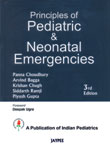|
|
|
Indian Pediatr 2012;49: 80-81
|
 |
Book Reviews |
|
 |
Pediatric Nephrology 5th Edition
RN Srivastava, Arvind Bagga
Jaypee Brothers Medical Publishers (P) Ltd; New Delhi: 2011.
Pages: 557; Price: 850/- |
This edition has been extensively revised and updated throughly. The chapters on electrolyte and acid base disorders and common kidney disorders of childhood like nephrotic syndrome, urinary tract infection, voiding disorders and neonatal renal disorders have been expanded. A new chapter on prevention of kidney diseases has been added. The edition is well illustrated with tables, figures and flow charts. The key points in text provide essential features to the reader for clear take home message. The book is printed in such a way to enhance its visual appeal and make reading an enjoyable experience. The appendices have included very useful information. The book has proved its usefulness over the years. This edition has further enhanced its value in understanding and managing kidney disorders in children. The book is strongly recommended to postgraduate students, practicing pediatrician and faculty members.
AK Rawat
Professtor and Head,
Department of Pediatrics,
Medical College,
Sagar, Madhya Pradesh, India.
Email: [email protected] |
 |
Principles of Perinatal and Pediatric HIV/AIDS
Mamatha M Lala and
Rashid H Merchant
Jaypee Brothers Medical Publisher;
New Delhi:2012.
Pages: 627; Price: Rs 1995/-.
|
There has been felt need for a textbook dealing with the vast subject of Pediatric HIV. This volume is an effort to fill in this gap. This comprehensive textbook deals with almost all the aspects of pediatric HIV in six sections. The chapters have been contributed by leading experts in the field. The text is well referenced. The liberal use of good quality figures is commendable. Algorithms and flow charts are also well used. Many chapters have case discussions, which will help the reader understand the practical issues well. Issues in perinatal HIV have also been discussed in detail. The provision of list of organizations supporting care of HIV infected children is a useful resource. The quality of publication is excellent. However, it would have been useful to have a separate chapter on antiretroviral therapy in children, with discussion of the regimens recommended in the country program. The practical aspects of initiation of antiretroviral therapy also needs strengthening. I strongly recommend this book to all health care professionals involved in the care of HIV infected children and women, and also for the postgraduates in pediatrics.
Rakesh Lodha
Associate Professor, Department of Pediatrics,
All India Institute of Medical Sciences,
New Delhi 110 029, India.
Email: [email protected]
|
 |
Principles of Pediatric & Neonatal Emergencies
Panna Choudhury, Arvind Bagga, Krishan Chugh, Siddarth Ramji and Piyush Gupta
Jaypee Brothers Medical Publishers 2011,
New Delhi.
Pages: 786, Price: Rs. 1095/-.
|
In the rapidly changing cutting edge field of Emergency Medicine, the need is always for incorporation of the latest research in to day-to-day practice. The book scores in this aspect by including the most recent guidelines, including those by the Indian Academy of Pediatrics, which adds to the topicality of the book. Although the 8 sections viz., Organization of Emergency Department, Resuscitation and Life-threatening Emergencies, Pediatric Medical Emergencies, Environment problems, Toxicological Emergencies, Neonatal Emergencies, Surgical Emergencies, and Emergency Procedures, continue from the previous edition; the subject-treatment is refreshingly different. With the addition of new contributors and new editors, the book appears to wear a new look. The detailed contents, better page quality, the two-color printing, and the enhanced table format make for easy reading. The addition of new color plates, which are placed separately at the beginning, is a welcome addition. More prominent headers placed at the lateral margin of the pages would have possibly improved readers’ accessibility to the desired section. Similar to the previous edition, Section 3 on pediatric medical emergencies is too long. Editors need to look into dividing it in 2 sections in future editions. All-in-all, a complete book on emergency pediatrics. It would be of help to both the residents, and also all physicians who handle sick patients at the first contact.
Devendra Mishra
Associate Professor
Department of Pediatrics
Maulana Azad Medical College,
New Delhi 110 002, India.
Email: [email protected]
|
|
 |
Approach to Pediatric Emergency
Jaydeep Choudhury and Jayanta Bandyopadhyay
Jaypee Brothers; New Delhi: 2011.
Pages: 509, Price: Rs. 495/-. |
This book aims to equip the pediatric caregiver with the essential real time knowledge to provide effective care to children in an emergency setting. The text spans the full scope of pediatric emergencies — from trauma care to neonatal, neurologic, surgical, dermatologic and ophthalmic emergencies – with sufficient detail, yet still maintains a concise, easy to read presentation, ideal for use in the emergency department or pediatric clinic. The chapters are complemented by pictures, charts, diagnostic algorithms and tables,sp thus ensuring the book will make crucial clinical information easy to find and apply.
Suchitra Ranjit
Senior Consultant, Pediatric Intensive Care
Head of Department, Pediatric Emergency and Intensive Care,
Apollo Children Hospital, Chennai.
Email: [email protected]
|
|
|
 |
|

